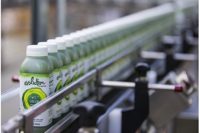Evolution Fresh announced plans to open a juicery that will support 160 U.S. manufacturing jobs in Rancho Cucamonga, Calif., later next year.
The Seattle-based division of Starbucks Corp. will open a high-tech juicery that will significantly expand the production and distribution capacity of Evolution Fresh juices. The juicery, which is expected to be operational in late 2013, will produce Evolution Fresh juices currently made at its existing juicery in San Bernardino, Calif. All 120 San Bernardino employees have been offered positions at the new facility, with 40 additional positions expected to be created once the juicery is fully operational.
“Our new juicery marks an important milestone as we continue to revolutionize the $3.4 billion and growing cold-crafted juice category,” says Jeff Hansberry, president, channel development. “It will more than quadruple our production and distribution capacity while continuing to deliver the flavor, vitamins and nutrients of raw fruits and vegetables retained by Evolution Fresh’s innovative use of high pressure processing.”
The $70 million, 260,000-square-foot juicery will be capable of peeling, squeezing, cracking and pressing approximately four to five times the amount of juice per year as the current facility using the company’s never-heated HPP technology. It will be Starbucks’ sixth manufacturing site in the United States, adding to the company’s existing network of four roasting plants in Kent, Wash.; York, Pa.; Sandy Run, S.C.; and Carson Valley, Nev., and a soluble coffee plant that is currently under construction in Augusta, Ga.
“During such challenging economic times, it’s important for Starbucks to continue to strengthen the U.S. manufacturing sector by investing in new facilities and creating jobs,” says Peter Gibbons, executive vice president, global supply chain operations. “We have long believed that there is a direct link between our success and the vitality of the communities in which we do business. This latest investment, along with the soluble coffee plant we recently broke ground on in Augusta, are good examples of how building high-tech manufacturing facilities in America makes good business sense by aligning our supply chain close to consumer demand while supporting the communities where our customers and partners live and work.”



